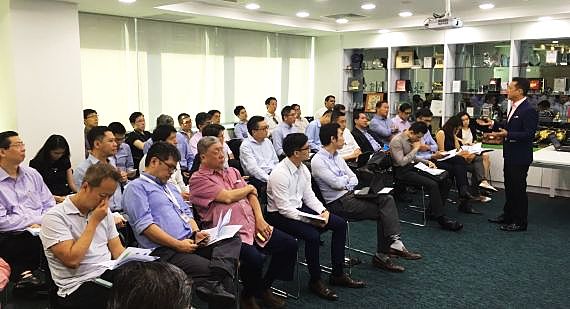Healthcare stocks usually command relatively high PE valuations, reflecting high investor expectations of their profitability and sustainability.
Group net profit was $830,000, compared to a $64,000 loss in 1H2015. |
|||||||||||||||
 Dr Beng Teck Liang at a packed 1H2016 results briefing this week.
Dr Beng Teck Liang at a packed 1H2016 results briefing this week.
Photo by James Bywater
Diagnostics segment is exciting growth area
| ♦ SMG is another RMG in the making? |
Attendee 1: I like the story so far. It sounds like you are Raffles Medical Group in its early days. Dr Beng: It’s a privilege to hear you say that. I look up to Dr Loo, and I think he has done a great job and he continues to carry the Singapore flag in healthcare. You can watch this space in the next 5-10 years and see whether I can carry the flag. Attendee 2 (on the companies’ acronyms having a similar ring): If I may point out … RMG, SMG. |
SMG's CEO, Dr Beng Teck Liang, says diagnostics holds exciting growth prospects because it is extremely scalable.
The manpower requirements are relatively lower, and the doctors and radiologists can read the scans whereever they are done in, including overseas centres.
Saying there's big growth potential outside of Singapore, he added: "Can I take diagnostic radiology to Vietnam and Indonesia? Absolutely."
SMG ventured into the diagnostics business segment in two steps, and have become encouraged by the turnaround of its acquisitions:
1. Through JV entity Lifescan Imaging, in August 2015, SMG acquired the radiology business of Pacific Cancer Centre for S$2.3 million cash. It thus gained access to radiology and diagnostic imaging assets, creating synergy amongst the Group’s suite of medical services.
This formerly loss-making business has been turned into a profitable entity.
2) SMG completed the acquisition of Novena Radiology on 1 April 2016 for S$0.6 million. This gives it a footprint of 9,000 square feet in Paragon and Novena. (Notably, while chief competitor Radlink and SMG have centres in Paragon, SMG now is dominant in Novena where Radlink does not have a presence).
 "We see our diagnostic business as a key growth driver for the Group with huge potential and room for expansion amidst an environment with growing demand for imaging related services."
"We see our diagnostic business as a key growth driver for the Group with huge potential and room for expansion amidst an environment with growing demand for imaging related services."
Subsequent to the results briefing, SMG announced that it proposed to acquire the remaining 61.9% of Lifescan that it does not own.
Dr Beng spoke about expanding the diagnostics segment also through buying more equipment. Though each machine costs $1-2 million, "the good thing is that hire purchase is very easy."
Not that SMG is short of cash. In fact, it had $7.3 million in cash versus $2.1 million in borrowings, as at end-June 2016.
Which is quite a bit for it to continue to prowl for M&A to grow its business.







